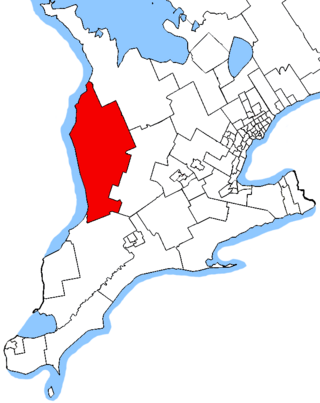
Bruce County is a county in Southwestern Ontario, Canada. It has eight lower-tier municipalities with a total 2016 population of 66,491. It is named for James Bruce, 8th Earl of Elgin and 12th Earl of Kincardine, the sixth Governor General of the Province of Canada. The Bruce name is also linked to the Bruce Trail and the Bruce Peninsula.

Huron—Bruce is a federal electoral district in Ontario, Canada, that has been represented in the House of Commons of Canada since 1953.
Brant North was a federal electoral district in Ontario, Canada, that was represented in the House of Commons of Canada from 1867 to 1893. It was created by the British North America Act of 1867 which divided the county of Brant into two ridings: Brant North and Brant South according to a traditional division.
Brant South was a federal and provincial electoral district in Ontario, Canada, that was represented in the House of Commons of Canada from 1867 to 1904, and in the Legislative Assembly of Ontario from 1867 to 1923.
Brockville was a federal electoral district in Ontario, Canada, that was represented in the House of Commons of Canada from 1867 to 1917. It was created by the British North America Act of 1867.
Bruce North was a federal electoral district in Ontario, Canada, that was represented in the House of Commons of Canada from 1867 to 1935. It was created by the British North America Act of 1867 which divided the county of Bruce into two ridings: Bruce North and Bruce South.

Durham West was a federal electoral district represented in the House of Commons of Canada from 1867 to 1904. It was located in the province of Ontario. It was created by the British North America Act of 1867 which divided the county of Durham into two ridings: Durham West and Durham East.
Elgin East was a federal electoral district represented in the House of Commons of Canada from 1867 to 1925. It was located in the province of Ontario. It was created by the British North America Act of 1867 which divided the county of Elgin into two ridings: Elgin East and Elgin West based on a traditional division.
Elgin West was a federal electoral district represented in the House of Commons of Canada from 1867 to 1935. It was located in the province of Ontario. It was created by the British North America Act of 1867 which divided the county of Elgin into two ridings: Elgin East and Elgin West based on a traditional division.
Haldimand was a federal electoral district in the province of Ontario, Canada, that was represented in the House of Commons of Canada from 1867 to 1892 and from 1904 to 1953. It was created by the British North America Act of 1867.
Huron North was a federal electoral district represented in the House of Commons of Canada from 1867 to 1882, and from 1917 to 1953. It was located in the province of Ontario. It was created by the British North America Act of 1867 which divided the County of Huron into two ridings: Huron North and Huron South.
Huron South was a federal electoral district in Ontario, Canada, that was represented in the House of Commons of Canada from 1867 to 1935. It was created by the British North America Act of 1867 which divided the County of Huron into two ridings: Huron North and Huron South.
Middlesex East was a former federal electoral district in Ontario, Canada, represented in the House of Commons of Canada from 1867 to 1968. It was created by the British North America Act of 1867, which divided the County of Middlesex into three ridings: Middlesex North, Middlesex West and Middlesex East.
Middlesex North was a federal electoral district in Ontario, Canada, that was represented in the House of Commons of Canada from 1867 to 1917. It was created by the British North America Act of 1867 which divided the County of Middlesex into three ridings: the Middlesex North, Middlesex West and Middlesex East.
Perth South was a federal electoral district represented in the House of Commons of Canada from 1867 to 1935. It was located in the province of Ontario. It was created by the British North America Act of 1867, which divided the County of Perth into two ridings. The South Riding of the County of Perth initially consisted of the Townships of Blanchard, Downie, South Easthope, Fullarton, Hibbert, and the Villages of Mitchell and St. Marys.
Bruce East was a federal electoral district in Ontario, Canada, that was represented in the House of Commons of Canada from 1882 to 1904. This riding was created in 1882 from parts of Bruce North and Bruce South ridings.
Huron West was a federal electoral district represented in the House of Commons of Canada from 1882 to 1917. It was located in the province of Ontario. This riding was created from parts of Huron Centre, Huron North and Huron South ridings.
Bruce West was a federal electoral district in Ontario, Canada, that was represented in the House of Commons of Canada from 1882 to 1904. This riding was created in 1882 from parts of Bruce North and Bruce South ridings.
Grey—Bruce was a federal electoral district represented in the House of Commons of Canada from 1935 to 1968. It was located in the province of Ontario. This riding was created in 1933 from parts of Bruce South and Grey Southeast ridings.
Also within the Bruce census division are two First Nations reserves:


